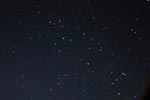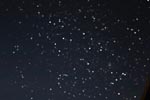A Processing
technique for displaying and
Printing
High Resolution Astro images
Uploaded 8/29/04

| As
I soon discovered with digitized film images take with my schmidt
camera or wide angle lenses, there are far more stars in an image
than is possible to display with an inkjet print with its often
horrendous halftone dithering, or especially on my "high
resolution" 19 inch monitor either full screen or web site
sized especially. By using the dilation filter in Pix Insight,
stars can be increased in size slightly without an loss of brightness
such as a Gaussian blur would do. This allows even the faintest
stars to be printed on such a small print as an 8x10, or viewed
on an even lower resolution monitor image. Here is an example
of this effect: |
 |
Left: 30 second exposure,
on ASA 100 film of Sagittarius during full moon. The stars are
so tiny even with this 1024 wide image, that 90 percent of them
are invisible!
(click on thumbnail
for the full size image)
|
 |
Left: after Pix Insights
dilation filter (similar to Photoshop Maximum filter) A small
amount of star enlargement reveals the faintest stars. You don't
want to make them huge disks - set for a very small amount of
dilation, such that the stars are all still extremely small pinpoints.
(click on thumbnail
for the full size image)
|
 HOME GALAXIES EMISSION NEBS REFLECTION NEBS COMETS
GLOBULARS OPEN CLUST PLANETARIES LINKS
HOME GALAXIES EMISSION NEBS REFLECTION NEBS COMETS
GLOBULARS OPEN CLUST PLANETARIES LINKS
You are visitor
number since June 17, 2001

FastCounter
by bCentral
Return
to Main CCD Page
Return
to Main Page Astrophotography Page

